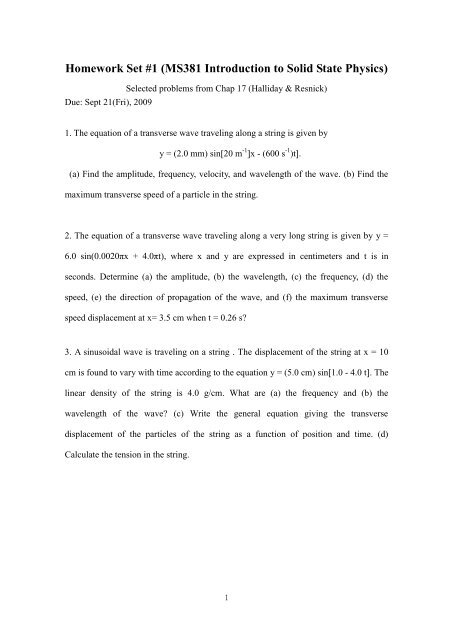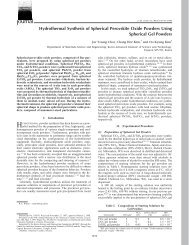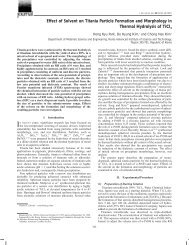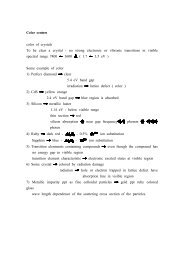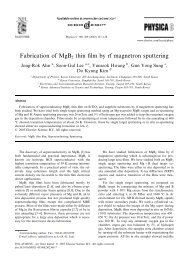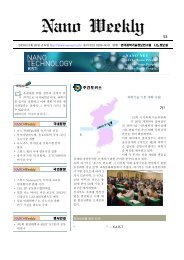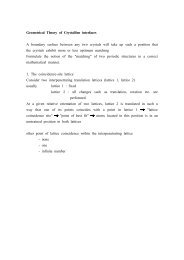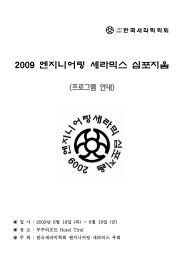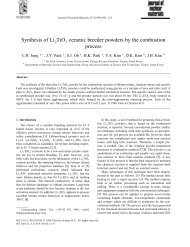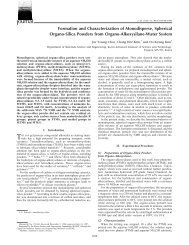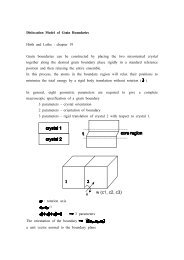Homework Set #1 (MS381 Introduction to Solid State Physics)
Homework Set #1 (MS381 Introduction to Solid State Physics)
Homework Set #1 (MS381 Introduction to Solid State Physics)
Create successful ePaper yourself
Turn your PDF publications into a flip-book with our unique Google optimized e-Paper software.
<strong>Homework</strong> <strong>Set</strong> <strong>#1</strong> (<strong>MS381</strong> <strong>Introduction</strong> <strong>to</strong> <strong>Solid</strong> <strong>State</strong> <strong>Physics</strong>)<br />
Due: Sept 21(Fri), 2009<br />
Selected problems from Chap 17 (Halliday & Resnick)<br />
1. The equation of a transverse wave traveling along a string is given by<br />
y = (2.0 mm) sin[20 m -1 ]x - (600 s -1 )t].<br />
(a) Find the amplitude, frequency, velocity, and wavelength of the wave. (b) Find the<br />
maximum transverse speed of a particle in the string.<br />
2. The equation of a transverse wave traveling along a very long string is given by y =<br />
6.0 sin(0.0020πx + 4.0πt), where x and y are expressed in centimeters and t is in<br />
seconds. Determine (a) the amplitude, (b) the wavelength, (c) the frequency, (d) the<br />
speed, (e) the direction of propagation of the wave, and (f) the maximum transverse<br />
speed displacement at x= 3.5 cm when t = 0.26 s?<br />
3. A sinusoidal wave is traveling on a string . The displacement of the string at x = 10<br />
cm is found <strong>to</strong> vary with time according <strong>to</strong> the equation y = (5.0 cm) sin[1.0 - 4.0 t]. The<br />
linear density of the string is 4.0 g/cm. What are (a) the frequency and (b) the<br />
wavelength of the wave? (c) Write the general equation giving the transverse<br />
displacement of the particles of the string as a function of position and time. (d)<br />
Calculate the tension in the string.<br />
1
4. A transverse sinusoidal wave is generated at one end of a long, horizontal string by a<br />
bar that moves up and down through a distance of 1.00 cm. The motion is continuous<br />
and is repeated regularly 120 times per second. The string has linear density 120 g/m<br />
and is kept under a tension of 90.0 N. Find (a) the maximum value of the transverse<br />
speed u and (b) the maximum value of the transverse component of the tension. (c)<br />
Show that the two maximum values calculated above occur at the same phase values for<br />
the wave. What is the transverse displacement y of the string at these phases? (d) What<br />
is the maximum rate of energy transfer along the string? (e) What is the transverse<br />
displacement y when this maximum transfer occurs? (f) What is the minimum rate of<br />
energy transfer along the string? (g) What is the transverse displacement y when this<br />
minimum transfer occurs?<br />
5. A nylon guitar string has a linear density of 7.2 g/m and is under a tension of 150 N.<br />
The fixed supports are 90 cm apart. The string is oscillation in the standing wave pattern<br />
shown below. Calculate the (a) speed, (b) wavelength, and (c) frequency of the traveling<br />
waves whose superposition gives this standing wave.<br />
2


